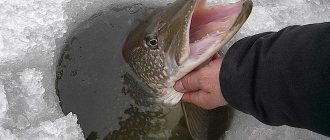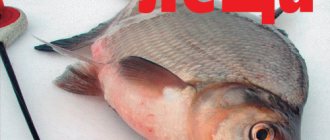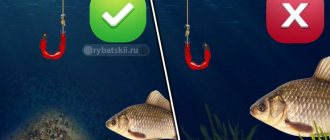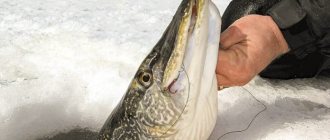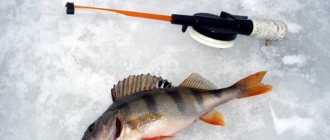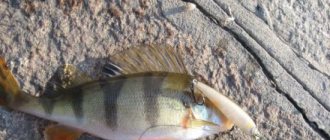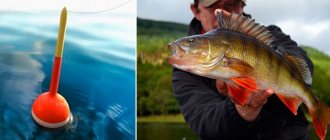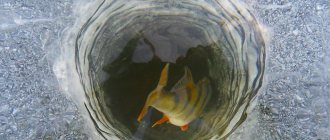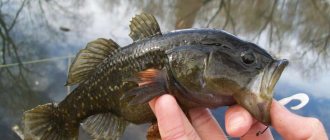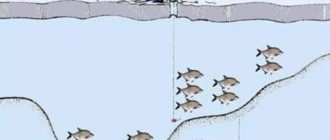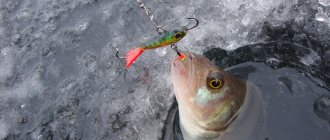Choosing gear for catching pike in winter using a balance beam and a spoon
Rod
For comfortable fishing, it is necessary that the total length of the blank be 50-70 cm. The whip is made of carbon fiber and is quite hard, but not as “oaky” as when fishing for pike perch, since pike’s mouth is not so bony. For fishing in shallow water, blanks of medium hardness and action are ideal; they allow you to dampen the jerks of the fish when playing, and at the same time, make it possible to control the process itself, preventing the fish from escaping into snags or reeds. It is advisable that the whip be equipped with 3-4 access rings.
The handle should fit comfortably in the hand and be made of cork or neon, and the rod itself, together with the reel, should have good balancing, since you will have to actively work with it.
Coil
In order to reduce the number of breaks, it is better to use a reel with a friction brake. Catching pike in winter with a balance beam and a plumb spinner, it is more convenient with inertial and multiplier reels, but you can also fish with inertia-free reels with a small spool size.
For those who believe that the simpler and lighter the tackle, the better, and in the old fashioned way, they fish for pike by hand, an ordinary reel is enough.
fishing line
Monofilament fishing line with a diameter of 0.25-0.3 mm, more is possible for trophy pike. When fishing at a depth of more than 6 m, and in cases of using reels, you can put a braided line, so that it does not freeze so much, use various protective silicones or antifreeze.
Habit: tungsten wire, guitar strings No. 5,6. Titanium strings are an excellent option, unlike guitar strings; even if the pike bends and bends them greatly during the fishing process, they will still remain straight.
For passive pike, it is better to use a fluorocarbon rod with a diameter of 0.35-0.45 mm.
How to fish with balance beams in winter
Fishing with balance beams in winter has a number of features. The bait needs to be immersed to the bottom, and then raised a few centimeters. Use the fishing rod to make a smooth swing and return the product to its original position. In this case, the bait swims to the side, turns around and returns to its original position.
When performing the next swing, you need to repeat the movement of the bait in the other direction. During the next two movements, the balancer describes a figure eight. If you play the bait several times near the bottom, you can shorten the line by 35-50 cm. In this case, you need to count the number of revolutions on the reels. In this way it is possible to fish the upper parts of the water.
Sometimes the fish is quite high - near the ice. In this case, you need to gradually lengthen the fishing line, returning the balancer to the bottom. After bites, fishing should continue at the same level. At the same time, if possible, the fish are raised even higher. This method helps to increase the rate of fishing.
The correct speed of swinging the rod is important. You shouldn’t sit on one hole for a long time without getting bites. At the same time, you shouldn’t change the place often either. Often it is enough to make up to 10 strokes of the fishing rod along the entire depth so that the fish located within the hole reacts to a moving object.
For fishing to be successful, the fish must first be teased. Only after this will she play the right game. The fishing technique using a balancer varies depending on the seasonal factor. This is due to the different behavior of fish depending on the time of year.
When using a balancer in winter, the angler is required to have high mobility. At the end of winter, the fish are quite hungry, and therefore become very aggressive. Therefore, bait fishing should be quite energetic. At the beginning of winter it is made less intense.
Choosing a balancer for pike fishing
Size
It’s better to start fishing with standard 7 cm balancers. If the activity of the pike is quite high, it makes sense to try larger baits about 9 cm long. At the same time, you need to be prepared for the fact that the biting activity will decrease significantly or disappear altogether, but you will cut off the bites of smaller individuals, and you will have a better chance of getting a trophy copy.
If the bite is weak when fishing with 7-centimeter balancers, then you should reduce the size of the bait to 4-5 centimeters; of course, in this case you will have to be content with medium-sized bee-eaters and perch.
I would also like to note that catching pike in winter with a large-sized spinner and balancer is successful at the beginning and end of winter, when the catfish is near, but in the dead of winter, it is better to catch with medium and small baits.
Plumage
Based on the presence of plumage, balancers can be divided into three types:
- Plumage made of metal or plastic;
- Fur or wool plumage;
- Feathers made of frost-resistant plastic, so-called silicone balancers.
Balancers with fur and wool plumage work well on passive pike.
Color
The color of the balancer plays a rather important role, but practice shows that it is impossible to say unambiguously when and with what color it is necessary to fish. Since pike preferences can change depending not only on the reservoir, but also on the day of fishing. Therefore, anglers are recommended to take with them as many balancers of different colors, shapes and plumage as possible.
But let's highlight three main palettes, without which there is no point in going out onto the pond:
- Dark;
- Acidic;
- Natural.
Natural balancers have a color similar to that of the fry. The perch color is very popular; in this case, the pike attacks not only prey, but also a competitor.
In sunny weather, it makes sense to use dark baits so as not to frighten the fish with glare from the sparkles.
Often, you can achieve an active bite by using bait of poisonous colors, they are especially effective during times of strong feeding, when the fish does not think much before attacking, it will simply notice such bait faster.
Hooks
For balancers, tees No. 4-6 are used, according to the international classification. When purchasing balancers, you need to pay attention to the hook, which is located in the body of the balancer; it must match the size and not stick to the body of the bait.
It has been noted that when catching pike with a balance beam and a spinner, various attachments, bright red colors, mounted on hooks can be an additional help for a good bite:
- Cambrics;
- Beads;
- Wool threads.
Winter trolling of pike on the first ice
You need to start fishing for pike on a balance beam on the first ice as soon as it becomes possible to safely go out onto the reservoir. The peak of predation activity occurs just during the period of ice formation, and then the pike bite gradually fades over the course of 10-15 days.
- The first ice, crunching dangerously underfoot, is transparent and smooth - the best time to hunt for a toothy one. At the same time, you must not forget about safety.
- You need to move together at a distance of 10 meters, take life preservers with you and, preferably, a rope for tying with a friend. It is believed that ice that is safe for walking is 7 cm. However, many anglers already walk on 4-5 cm of ice. On such thin cover, if you go out despite the recommendations of the Ministry of Emergency Situations, you need to behave extremely carefully.
- We focus not on specific baits - balancers, spoons or ratlins, but on search tactics. Pike in the first ice will grab most of the baits that the angler offers. However, for this you need to choose the right fishing points. At the same time, exact timing of predator exits is often observed in a reservoir. Therefore, you need to get not only to the right place, but also at the right time.
- Unlike stationary baits, fishing with a spoon or balancer allows you to actively search for pike between the predator’s exits. At the same time, when the toothy one is standing, we drill holes more often. During a pause in the bite, the bait should be thrown directly under the pike’s nose, no further than 2-3 meters from the ambush site.
Choice of spinners
Material
Copper, zinc, bronze or brass are mainly used to make spinners. Much more effective are spinners made from a combination of materials, such as copper and brass, silver and copper. Such spinners additionally create an area of increased electric field around themselves.
Shape, length and weight
For pike, the shape of the spoon is wide, it allows it to plan better and produce oscillations with greater amplitude. The exception is spinners, which are used for fishing in the current; they have a narrow-bodied shape; read more about catching pike in winter on the river here .
The classic size of spinners for pike is 6-12 cm. But again, catching pike in winter with a balance beam and a spinner, with an active predator, is more effective with large-sized baits, and with a passive one, small ones.
The weight of the bait is selected depending on the fishing depth and the presence of current and ranges from 10 to 40 grams. True, when fishing in shallow water, at a depth of less than one meter, it is worth using a spinner weighing less than 10 grams.
Color
Regarding the choice of color, again it all depends on the preference of the pike at the moment, but still I would highlight several recommendations:
- At depth and in cloudy weather, start fishing with light-colored spinners. In clear weather and in shallow water, use dark-colored lures.
- If you have a metallic-colored spinner, then it is advisable that it have a special notch on it that will imitate scales.
- In cloudy water, it is better to use lures of acidic colors;
- If the lure has a natural color, then red spots that will imitate wounds of the fish can give a good result.
- Holographic stickers can be an additional attractive factor for the spinner.
But again, you always need to take different options of spinners with you.
Hooks
For catching small pike, when perch also bites at the same time, a single hook is enough; it is easier to unhook. But to catch more respectable specimens, it is better to use a tee, with it the probability of catching a catfish is much higher.
Spoons for pike in the first ice
Catching pike with a spoon on the first ice is no less effective. By and large, when the toothy one takes everything, you can catch it vertically with an ordinary summer spoon. The spinner will perform gliding oscillations. The principle of tactics is the same - we drill more and check the holes.
The game is normal, tosses and pauses. If the pike is standing under the hole, then you need to lower the spoon immediately after lowering it into the water. Toothy often grabs the piece of iron at the first fall - you need to be mentally prepared for this in order to have time to make a hook.
Any medium or large size spinner for pike on the first ice will be useful. Both winter vlasovki, trihedrons and fry work, as well as summer atoms, wobblers or spoons. Pike can take on a nail or loose fish. However, the predator prefers oscillatory movements and gliding with a deviation to the side.
Since the weight of pike spinners is comparable to large balancers, we use the same tackle described above. Typically, fishermen do not focus specifically on a balancer or some kind of spoon. You need to start your search with your favorite bait, which the angler believes in, no matter whether it is a spoon or a balancer. Article about fishing for pike with lures
Features of wiring and fishing tactics
Fishing tactics
When catching pike in winter with a balance beam and a spinner, we make holes at intervals of 5-10 m. It is worth considering that if your balance rod has a wide game, then the distance between the holes can be made within 8-10 m.
But if you come across promising places on your way, for example a snag, then it’s worth fishing for it separately. Reducing the distance between holes also makes sense for passive pike.
First we drill 10 holes, then, without creating unnecessary noise, we return to the first one and start fishing from there. In shallow water, 2-3 three minutes is enough to fish a hole, because if there is fish, it will definitely see the bait, but at depth, due to poorer visibility, you can increase the fishing time to 5-6 minutes per hole.
Then we make the next series of holes and return to the first hole we drilled, so we have already fished 20 holes. This is done for the following purpose: if we spooked the fish during drilling, then it could return, and we will catch it during repeated fishing.
If we were not lucky when fishing the first ten holes, then when fishing again we change the bait, try another game, if in this case there is no result, then we collect the gear and move away 500 meters.
Wiring for catching pike in winter with a spinner
- We lower the spoon to the bottom;
- Then raise it to a height of 5-15 cm;
- We carry out the game by raising the rod up to a height of 25-40 cm, with pauses between raising the rod for 3-6 seconds.
Further, the game of the spinner can change: the swings of the rod can be made smoother or, on the contrary, sharper. If the predator is passive, it is worth trying to increase the pause between postings.
Also, from time to time it makes sense to increase the lifting height of the rod, fishing in the upper layers of the water.
If the bottom is muddy, you can let the bait fall to the bottom, resulting in a cloud of turbidity that may interest a predator.
Balance game
The key to high-quality balancing play is smooth movements.
We lower the balancer to the bottom, take a short pause of 5 seconds, then tap the bottom with 5-6 blows of the balancer. We wait a short pause and raise the balancer 20-30 cm up. And we carry out smooth swings of the rod to a height of 20 cm, while there is no pause between swings.
You can also raise the balancer to a height of 50-70 cm and then lower it back. You can lower it by making several intermediate stops.
Search and catch tactics
How exactly to catch pike on the first ice with balance beams or spoons depends on the configuration of the reservoir. The pattern of drilling holes and fishing depend on local conditions and the habits of the fisherman.
- The first promising places for catching pike in the first ice are water areas near the edge of the reed wall, windows in the thickets, and a drop-off that begins immediately beyond the edge. In this case, we drill holes at a distance of 5-10 meters along the line of thickets directly next to the bushes, and the second row is also along, but at a distance of 1-3 meters from the wall.
- We methodically fish the wall of bushes along its entire length, especially in areas with an uneven configuration - bays, protruding parts, a scattering of sparse vegetation near dense, sharper drops in depth than in other areas.
- If the study of the coastal strip does not bring results, we look deeper, checking the slopes, edges and the area from the vegetation cut to the riverbed in a checkerboard pattern.
- Promising points are also anomalies and deviations in the relief, bends of the coastline and deep areas among shallow waters, bays behind the cape, spits and stone placers, snags and old trees that have fallen into the water.
- Entrances and exits to quiet reaches and pits.
- Shallow waters and flooded bushes with depths of up to a meter - sometimes pike stand here on the first ice.
Large pike often stand deeper, in shelters or on uneven riverbeds, under the edges. Such individuals feed on larger fish, but they will also catch them on the balance beam in the first ice. Therefore, if, with an abundance of small pike, the target is trophy specimens, we use the largest balancers and spoons, checking for deep anomalies.
On the first ice, all the rules for winter pike fishing with balance beams apply. To some extent, at the beginning of winter it is easier to catch a toothy one. When the bite is good, you don’t need to stay on one hole; if you don’t get it, it’s better to check more places and baits. During the feeding season, when the toothy one walks through the pond, from one hole, if you get on the path, you can catch several pikes.
Silence and disguise
The first ice is transparent, and at this time the pike sees the angler. This is especially true in small places without shelter, grass, and in sunny weather. On some reservoirs, pike do not reach areas with glass-clear ice if anglers move across it. First of all, you should fish areas shaded from the sun - snow drifts, pieces with cloudy or matte ice.
During the fishing process, you should observe camouflage - do not make noise, do not run, do not throw objects on the ice. There is no need to move from hole to hole with all your swag, rattling your sled or box. It’s better to leave the sled in one place, then drill 10-20 holes at once, and then fish one by one, moving between points as quietly as possible.
Catching pike in winter with a balancer and spoon, choosing a fishing point
It is better to catch pike in a familiar body of water or having studied it in advance with the help of an echo sounder (for example, in late autumn).
On the first ice, the pike is quite active and is in shallow water, where it actively hunts for fry; it can stand at the edge of the reeds at a depth of only a few tens of centimeters.
But do not forget that large pike prefer deep-sea places. Many anglers start fishing shallow waters and gradually move to deeper areas.
We are interested in bays, small bays, creeks, and lakes. You can also meet pike on the river; here it is worth fishing for bends and turns of the riverbed, places with reverse flows, backwaters, areas with a broken coastline, and steep steep banks.
You should look for pike on deep dumps, only it should not be steep, but flat, ideally with steps, in holes and pools, in places rich in aquatic vegetation, at the edge of reeds, on the bottom strewn with snags, on water tables.
In addition, we are interested in any noticeable changes in depth, for example, the presence at the bottom of a ditch about half a meter deep, a ledge, or a pile of stones.
After two to three weeks, the activity of pike decreases significantly, and the fish moves to places rich in oxygen: confluence points of rivers and streams, underwater springs, old river beds or deeper water areas.
Often during this period, in small standing reservoirs, pike activity is reduced to almost zero, so now it is better to turn your attention to large reservoirs.
Closer to the beginning of spring, pike returns to shallow waters and its activity increases again.
The best time for pike fishing is morning dawn and evening sunset. Many fishermen come to the pond while it is still dark in order to have time to drill holes in advance and start fishing at dawn. You can catch catfish during the day and at night.
Types of balancers
The classic balancer is a small artificial fish that is tied to a fishing line in the dorsal fin area. The bait is equipped with two soldered hooks in the head and tail, as well as a tee located on the abdomen. Instead of a plastic tail, some models are equipped with an edge or a silicone body kit. Under the ice, the bait performs sweeping movements. As for the leaders in this class of lures, experts consider Finnish balancers to be the best products. Inexpensive models from China, most of which are copied from popular brands, are simply ignored by perch. We can conclude that it is not the size and color that play a primary role in the catchability of the bait. The secret of the “killer balancer” should be found in his game.
How to choose a balancer?
Size
This parameter in most cases is determined by what kind of fish you want to catch. If, for example, you plan to catch fish such as perch, then you should choose not very large specimens, since a large size can scare away the perch.
If the goal of fishing is a larger fish, then you can safely experiment with sizes. The biggest fish will not always bite the biggest bait, this is a big misconception. A large specimen can respond to a fairly small balancer.
Form
The choice of shapes in fishing stores is becoming larger and larger. In fact, there is no universal form that would suit all conditions at once. You will have to buy several different options, and then test them, only then will you be able to choose a favorite for yourself.
Only by trying new and new lures will you be able to build your arsenal of the best balancers with which you can achieve the desired results.
Color
The variety of colors is also great. Brighter colors are great for murky water as they will stand out a bit, thereby attracting fish. Darker models can be used on reservoirs with rocky bottoms.
Dark baits will look most realistic in such conditions, which will not arouse any suspicion in the fish. It is best to purchase several different balancers at once, which will be painted in different colors. If suddenly a predator does not want to respond to one balancer, you can always replace it with another.
Price
The price for such pleasure is quite reasonable. For an inexpensive Chinese version, which will be quite well assembled and also have a good game, you will have to pay approximately from 350 to 700 rubles . For a catchable bait, this is not so much.
If you want to purchase a more expensive option, which will be manufactured by some well-known brand, then you can safely prepare for its purchase from 800 to 3000 rubles. Such a balancer will be very good. It will also be assembled with very high quality, high-quality, expensive hooks will be built into it, which will not let you down.
Tackle for balancer
This bait requires fairly clear and informative control, which is why rods with a rigid rod are often used for such fishing. Such a fishing rod will allow you to make very precise movements, and will also help you make sharp hooks.
It is also worth saying that a rigid fishing rod is much more convenient when fishing for large specimens; you will always have clear control over your prey. The reel can be used either regular or spinning. Since the line is not reeled out often, there is no point in having large and powerful reels.
Catching perch on a balancer - fishing features
Far from the last place among baits for catching perch in winter is the balancer. It is made in the form of a small fish, equipped with two single hooks and a tee. The bait is attached to a ring located strictly in the center of the back. Balance fishing for perch requires constant movement and fishing of prepared holes. In the current material, we will look at the intricacies of this process: choosing a balancer and fishing line, preparing gear, fishing techniques and game options.
Features of catching perch on a balance beam
Using a bait in the form of a balancer, an angler can count on both perch and pike with zander. The success of fishing depends on constant movement and good knowledge of the area. The balancer is available in different colors, but the most catchy and popular are those painted in bright colors.
When located at shallow depths, you should use a light-weight bait, taking short pauses (no more than 10 seconds) between plays. During fishing, movements become sharp, but neat.
The balancer is similar in its characteristics to the spinner, but has distinctive features that increase its effectiveness:
- The appearance is similar to that of a juvenile, attracting predators. The tail unit adds additional similarity.
- Thanks to the precise centering of the fastening ring, the balancer is constantly in a horizontal position, reminiscent of a live fish in its behavior.
- The tee located under the belly increases the chance of a successful bite.
- A wide range of colors and weights ensures successful selection of bait depending on the parameters of the perch.
